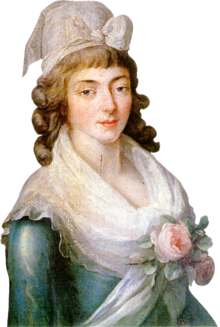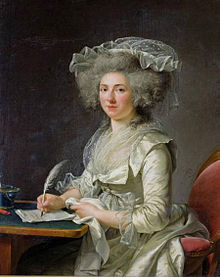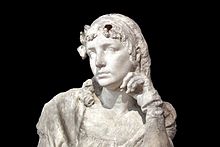- Madame Roland
-
Marie-Jeanne Roland de la Platière 
Portrait of Madame RolandBorn Marie-Jeanne Phlipon
March 17, 1754
Paris, FranceDied November 8, 1793 (aged 39)
Paris, FranceCause of death guillotine during Reign of Terror Residence Lyon, France and Paris, France Nationality French Other names Madame Roland Ethnicity French Citizenship French Education self-taught Known for salon, Girondist faction of French revolution, wrote political articles Political party Girondist faction Opponent(s) Robespierre Spouse Jean-Marie Roland de la Platière Parents Gatien Phlipon  Portrait of Madame Roland by Adelaide Labille-Guiard (1787)
Portrait of Madame Roland by Adelaide Labille-Guiard (1787)
Marie-Jeanne Roland, better known simply as Madame Roland and born Marie-Jeanne Phlipon (17 March 1754 – 8 November 1793), was, together with her husband Jean-Marie Roland de la Platière, a supporter of the French Revolution and influential member of the Girondist faction. She fell out of favour during the Reign of Terror and died on the guillotine.
Contents
Early years
Madame Roland was born as Marie-Jean Phlipon in 1754 and was the only child of seven to survive the first year in the home of Pierre Gacien and Marguerite Binot Phlipon. From her early years she was a successful, enthusiastic, talented student. From the beginning she was strong willed and resisted doing anything that did not agree with her sensibilities. She frequently challenged her father and instructors as she progressed through an advanced, well-rounded education. Trained to the standards of the advanced French middledom as well as being an accomplished musician and dancer. An avid, self-motivated reader, she read Plutarch's "Parallel Lives by age 9. Plutarch formed the most important foundation of her philosophical ideals and beliefs and led her to embrace the fundamental ideals that the state existed for the well being of its citizens, not the benefit of a monarch, and every citizen shares in the responsibility for the success of the state. Thereafter she was also strongly influenced by Bossuet, Massillon, and similar authors, and most importantly by Montesquieu, Voltaire and Rousseau. As her studies developed under the influence of these authors, she abandoned the idea of entering a convent, and developed a strong preference for the republic as the ideal form of government.
Manon Phlipon (as her close friends and relatives called her) also, as she traveled, developed an increasing awareness of the outside world. In 1774, on a trip to Versailles, some of her most famous letters were sent to her friend Sophie, wherein she first begins to display an interest in politics, describing the perfect government as one which contained "enlightened and well-meaning ministers, a young prince docile to their council who wants to do good, a lovable and well doing queen, an easy court, pleasant and decent, an honorable legislative body, a charming people who wants nothing but the power to love its master...".[citation needed] Already, Manon was disregarding the idea of an absolute monarchy by placing the authority and importance of government ministers before the crown.
Marriage and political activity
She married Jean-Marie Roland in 1781, every bit his equal in intellect and character, even though he was more than 20 years older than she. With him and through him, she exercised a singularly powerful influence over the destiny of France.
In 1784, she obtained a promotion for her husband which transferred him to Lyon, where she began building her network of friends and associates. In Lyon, the Rolands began to express their political support for the revolution through letters to the journal Patriote Français. Their voice was noticed and in November 1790, Jean-Marie was elected to represent Lyon in Paris, negotiating a loan to reduce the debt of Lyon. When the couple moved from Lyon to Paris in 1791, she began to take an even more active role. Her salon at the Hotel Britannique in Paris became the rendezvous of Brissot, Pétion, Robespierre and other leaders of the popular movement. An especially esteemed guest was Buzot, whom she loved with platonic enthusiasm. These leaders of the Girondist faction of the Jacobin Club met to discuss the rights of citizens and strategies to transform the French from subjects of the Monarchy into citizens of a constitutional republic.
In person, Madame Roland is said to have been attractive but not beautiful; her ideas were clear and far-reaching, her manner calm, and her power of observation extremely acute. Madame Roland’s ability to weave social networks fed the Rolands' growing popularity; an invitation from Madame Roland would signify acknowledged importance to the developing French government. It was through Manon that one gained access to the inner circle of the growing Gironde. Inevitably, her activity placed her in the centre of political aspirations where she swayed a company of the most talented men of progress.
She began this movement toward political involvement slowly, starting out simply by working as a secretary for her husband. As time went on, however, she found that she could tweak his letters and still sign them in his name, as he appreciated her input and assistance. Following her husband’s rise within the Girondist group, Madame Roland attained more and more influence over it. She never spoke during formal meetings, though her ideals were well known and represented. Whenever M. Roland spoke, it was generally known that he was speaking also for her. The Gironde policies reflected her sentiments. Though the Girondist movement would eventually split into factions, for a time the whole group remained united in forcing the resignation of the ministers.
Madame Roland and her husband defected from the Jacobins in early 1792 and, with Jacques-Pierre Brissot, formed the moderate Girondin party. Monsieur Roland became minister of the interior, and Madame Roland continued as his confidante and advisor. She also authored much of his official correspondence, including the letter to the King of June 21, 1792, which urged the King to publicly pledge his loyalty and cooperation to the new republic, or suffer the consequences of escalating civil unrest. Madame Roland’s sharply worded passion cost her husband his ministry, but satisfied Madame Roland’s pride and passion. Her letter to the King could be considered the peak of her political influence. After Monsieur Roland made a stand against the worst excesses of the Revolution, however, the couple became unpopular. Once, Madame Roland appeared personally in the Assembly to repel the falsehoods of an accuser, and her ease and dignity evoked enthusiasm and compelled acquittal. Her drive, focus, and radiant intelligence made her the equal in accomplishments of any contemporary male politician.
Nevertheless, the accusations mounted. On the morning of 1 June 1793, she, along with other Girondins, was arrested for treason and, as a woman who had betrayed her sex, for her political activism. She was thrown into the prison of the Abbaye. Her husband escaped to Rouen with her help. Released for an hour from the Abbaye, she was again arrested and placed in Sainte-Pelagie, and finally transferred to the Conciergerie. In prison, she was respected by the guards, and was allowed the privilege of writing materials and occasional visits from devoted friends. There, she wrote her Appel à l'impartiale postérité, memoirs which display a strange alternation between self-praise and love of country, the trivial and the sublime. She was tried on trumped-up charges of harbouring royalist sympathies, but it was plain that her death was part of Robespierre's purge of the Girondist opposition.
Imprisonment and death
Perhaps some of the most interesting days of Madame Roland’s life took place in prison as she struggled with her concept of a woman’s place in the nation of France after having been forced to lurk in the shadows to gain her own influence over the nation. Though she had earlier stated that she would "rather chew off (her own) fingers than become a writer," Madame Roland began writing her memoirs during her stay in prison. Madame Roland wrote her memoirs in five months, with sections smuggled from the prison by her frequent guests. In her memoirs, she reflected upon her studies, passions, and political events. Madame Roland climbed the political scale by editing and modifying her husband’s platform but she established her historical significance through her recorded memoirs. Manon proved that women could significantly affect national politics. She proved women to be valuable active partners to political success. After Madame Roland helped her husband escape Paris, she accepted her fate of death on the guillotine as the only way to clear her name and reputation. Refusing to compromise her principles and remaining true to the ideals of Rousseau, Voltaire, and Plutarch, she died as a citizen of the republic, not a subject of the monarchy. After the revolution, her memoirs were published in 1795, so that Madame Roland continued to influence the formation of the French republic.
On 8 November 1793, she was conveyed to the guillotine. Before placing her head on the block, she bowed before the clay statue of Liberty in the Place de la Révolution, uttering the famous remark for which she is remembered:
O Liberté, que de crimes on commet en ton nom! (Oh Liberty, what crimes are committed in thy name!)
Her corpse was disposed of in the Madeleine Cemetery. Two days after her execution, her husband, Jean-Marie Roland, committed suicide on a country lane outside Rouen.
References
 This article incorporates text from a publication now in the public domain: Chisholm, Hugh, ed (1911). Encyclopædia Britannica (11th ed.). Cambridge University Press. The 1911 Encyclopaedia Britannica, in turn, gives the following references:
This article incorporates text from a publication now in the public domain: Chisholm, Hugh, ed (1911). Encyclopædia Britannica (11th ed.). Cambridge University Press. The 1911 Encyclopaedia Britannica, in turn, gives the following references:- Madame Roland's Memoires, first printed in 1795, have been edited among others by P. Faugere (Paris, 1864), by C. A. Dauban (Paris, 1864), by J. Claretie (Paris, 1884), and by C. Perroud (Paris, 1905). Some of her Lettres inedites have been published by C. A. Dauban (Paris, 1867), and a critical edition of her Lettres by C. Perroud (Paris, 1900-2).
- C.A. Dauban, Etude sur Madame Roland et son temps (Paris, 1864)
- V. Lamy, Deux femmes célèbres, Madame Roland et Charlotte Corday (Paris, 1884)
- C. Bader, Madame Roland, d'après des lettres et des manuscrits inédits (Paris, 1892)
- A.J. Lambert, Le ménage de Madame Roland, trois années de correspondance amoureuse (Paris, 1896)
- Austin Dobson, Four Frenchwomen (London, 1890) articles by C. Perroud in the review La Revolution française (1896-99).
- Kathryn Ann Kadane, "The Real Difference between Manon Phlipon and Madame Roland," French Historical Studies, Vol. 3, No. 4 (Autumn 1964), http://links.jstor.org/sici?sici=0016-1071%28196423%293%3A4%3C542%3ATRDBMP%3E2.0.CO%3B2-M
- Brigitte Syzmanek, “French Women’s Revolutionary Writings: Maname Roland or the Pleasure of the Mask,” Tulsa Studies in Women’s Literature, Vol. 15, No. 1 (Spring 1996), http://www.jstor.org/view/07327730/ap020030/02a00080/10?frame=noframe&userID=c63cc0dd@albertson.edu/01c0a834740050788b0&dpi=3&config=jstor
- Gita May, Madame Roland and The Age of Revolution (New York: Columbia University Press, 1970).
- Schama, Simon. Citizens, A Chronicle of the French Revolution. NY: Knopf, 1989.
- Dalton, Susan. "Gender and the Shifting of Revolutionary Politics: The case for Madame Roland." Canadian Journal of History, 36,no2: 259 36, no. 2 (2001): 259-.
- Underwood, Sarah. Heroines of free thought. NY: Somersby, 1876.
- Winegarten, Renee. "Women and Politics: Madame Roland." New Criterion18, no 2 18, no. 2 (October 1999).
- May, Gita. Madame Roland and the Age of Revolution. NY: Columbia University Press, 1970.
- Roland, Madame. The Private Memoirs of Madame Roland. Edited by Edward Gilpin Johnson. Chicago, Illinois: A. C. McClurg and Co., 1900.
Categories:- 1754 births
- 1793 deaths
- People executed by guillotine during the French Revolution
- Salon-holders
- People of the French Revolution
- Executed French women
Wikimedia Foundation. 2010.

